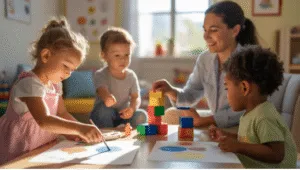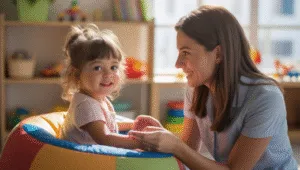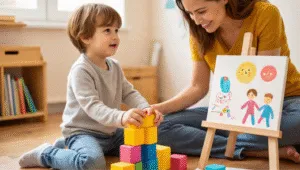Whole child therapy helps every part of a child grow: body, brain, and heart. It is not the case of one problem alone. It takes care of all speech, movement, and feelings as well as behavior simultaneously. Kids feel secure, noticed, and encouraged in all their steps. This treatment assists them to be strong in school, at home, and in the company of other people. It creates a healthy and complete life, inwardly and outwardly.

The Whole Child Occupational Therapy
The whole child occupational therapy children are able to do things independently with the help of learning simple skills. They are taught to dress, eat on their own, and write. This creates confidence and control feelings. Regular practice builds the strength of children with sensory or attention difficulties.
We do not cure a child. We support them so that they are successful. In whole-child therapy, each individual step matters. The task of therapists and parents is to make daily life comfortable and happier.
Whole Child Pediatric Therapy
Whole child pediatric therapy Care is all sorts of aid – verbal, tangible, and emotional. It monitors the way a child sleeps, eats, and acts. There might be more than one area of care that a sad child needs. Care is anything we do to assist. It may be chatting, donating something, or simply being around. We take into consideration the manner in which a child sleeps, eats, and behaves. A depressed child may require assistance in a number of things.

How Whole Child Therapy Builds Confidence
Trust does not come along overnight. Whole child therapy helps by building skills slowly. Children are taught how to speak, walk, or relax. As they win, it makes them even stronger and more courageous. The treatment reminds the children that they are above being a problem. They are lovable and competent. This is a way of altering their perception of self and the world. Parents observe the tears being changed by smiles.
When Whole Child Therapy Feels Hard
Treatment may appear to be slow or tiresome. Children might not wish to attend the effort. Parents may feel depressed or lost. That’s normal. Whole-child therapy does not discriminate but is a process.
One has ups and downs. Even tough days can be the means to grow. The therapists allow the children and parents to persevere. United, they create hope and a cure.

How Parents Help in Whole Child Therapy
Parents contribute to the advancement. In whole child therapy, they learn to help at home. The big changes can be supported by such simple means as songs, pictures, or short tasks.
The therapists facilitate easy procedures that should be undertaken by the parents. When parents participate, kids are made to feel safer and loved. That is the beginning of the healing during therapy, and back at home.
Whole Child Therapy vs. Traditional Therapy
Conventional therapy tends to cure one issue at a time. Whole child therapy, however, looks at everything—how a child feels, eats, plays, and sleeps. It does not only focus on symptoms, but on the cause. This broader perspective brings out a deeper longer longer-lasting therapy. A child with sitting problems could be, in fact, struggling with the feeling or sensory department. That is the strength of the whole child approach.

How Speech Fits into Whole Child Therapy
Much speech and language delay is normal among growing children. Whole child therapy is usually an aid in speaking, hearing, and applying words. Children can require assistance when they must request something, participate in play, or be very clear.
Many families now choose online speech therapy for children to add extra support. It is flexible, simple, and it goes hand in hand with a whole-child plan. Children are able to talk and broadcast themselves through online sessions from the comfort of their homes.

Real-Life Success Stories from Whole Child Therapy
At the age of three, Emma could not even talk. After many months of whole-child therapy, she can now sing songs and tell stories. This is what her parents term as a blessing.
Ali would make a habit of throwing toys and crying around. Now he talks and offers hugs. Lina was formerly scared of sounds and lights. She is sprightly about now. These narratives demonstrate the way complete care is a complete change.
Final Thoughts: Is Whole Child Therapy Right for You?
Whole child therapy works on the whole child. It does wonders in and out, unexpectedly but profoundly. It is nice and powerful. It comes with hope and permanent change with hard work.
Begin now and engage your child in case he or she is experiencing difficulties. The treatment is soft and effective. Therapy games for kids can be an important component of this approach. It also makes the children feel happy, peaceful, and grow in small steps.
FAQS
Q1: What does whole child therapy mean?
A: It is a comprehensive regime that enables the body, mind, and emotions of a child to develop collectively.
Q2: Does whole child therapy work better than ordinary therapy?
A: Yes. It does not take one problem to fix, but the whole child.
Q3: Who requires the therapy of the whole child?
A: Any child who is experiencing problems with speech, attention, behavior, and general life activities can use it.
Q4: Is this therapy something that can be assisted by parents at home?
A: Yes. To help their child in everyday life, therapists provide parents with the tools and activities.
Q5. Does this approach include online speech therapy for children?
A: Yes, it can be employed as a single component of the whole child therapy scheme.
